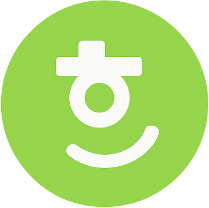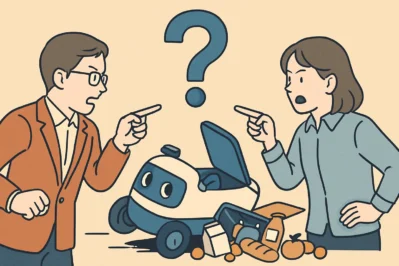AI’s Mistake, Whose Fault? Let’s Debate in Korean!
Hello! This is Maeil Hangul (매일한글), here to upgrade your Korean skills!
Have you ever used an AI service that gave you a weird answer? Or seen a delivery robot get stuck on the sidewalk? As AI becomes a bigger part of our lives, a new question arises: If an AI makes a mistake, who is responsible?
Lately in Korea, this is a super hot topic! With the rise of AI-powered customer service, self-driving cars being tested on the roads of Seoul, and even AI composing K-pop songs, conversations about AI ethics and responsibility are happening everywhere, from TV news to casual chats among friends.
Today, we’ll learn the essential Korean expressions to jump right into this fascinating debate. Let’s get started!
Core Expressions for Your Debate Toolkit
Here are four key phrases you need to discuss responsibility like a pro.
1. 책임 소재 (chaeg-im so-jae)
- Pronunciation: [chae-gim so-jae]
- English Meaning: Where responsibility lies; liability.
- Detailed Explanation: This is a slightly formal but very common term you’ll hear in discussions and news reports. It’s a compound word: 책임 (chaeg-im) means ‘responsibility,’ and 소재 (so-jae) means ‘location’ or ‘whereabouts.’ So, you’re literally asking, “Where is the responsibility located?” It’s the perfect, precise term for discussing who is officially accountable.
2. ~(으)ㄹ 탓이다 (~(eu)l tat-i-da)
- Pronunciation: [~(eu)l ta-shi-da]
- English Meaning: It’s the fault of…; to blame…
- Detailed Explanation: This grammar pattern is used to assign blame or point out the cause of a negative result. You attach it to a noun. If the noun ends in a vowel, you use 탓이다 (e.g., 사용자 탓이다 – It’s the user’s fault). If it ends in a consonant, you use 은/는 탓이다 (e.g., 개발자는 탓이다 – It’s the developer’s fault). This expression carries a nuance of blame, so it’s stronger than simply stating the cause.
- Example: 그건 AI를 만든 개발자 탓이야. (That’s the fault of the developer who made the AI.)
3. ~에 달려 있다 (~e dal-lyeo it-da)
- Pronunciation: [~e dal-lyeo it-da]
- English Meaning: It depends on…
- Detailed Explanation: This is a crucial phrase for any nuanced discussion! It allows you to express that the outcome is conditional. It literally means “to be hanging on something.” Think of a result “hanging” on a specific condition. You can use it to sound thoughtful and avoid making absolute statements.
- Example: 누구의 잘못인지는 상황에 달려 있어요. (Whose fault it is depends on the situation.)
4. 따지고 보면 (tta-ji-go bo-myeon)
- Pronunciation: [tta-ji-go bo-myeon]
- English Meaning: When you get down to it…; If you think about it carefully…
- Detailed Explanation: This is a fantastic discourse marker to introduce a deeper point or a counter-argument. 따지다 (ttajida) means “to question” or “to get to the bottom of something.” So, 따지고 보면 means “if you really dig in and look at it.” Use this to make your argument sound more persuasive and fluent.
Example Dialogue
Let’s see how these expressions work in a real conversation. Min-jun and Sora are talking about a news story where an AI-powered delivery robot caused a small accident.
A (민준): 어제 뉴스 봤어? 배달 로봇이 사고 낸 거. 책임 소재가 불분명하대.
(Did you see the news yesterday? About the delivery robot that caused an accident. They say the liability is unclear.)
B (소라): 응, 봤어. 나는 AI를 잘못 사용한 가게 탓이라고 생각해.
(Yeah, I saw it. I think it’s the fault of the store that used the AI incorrectly.)
A (민준): 그런가? 근데 따지고 보면, 애초에 완벽하지 않은 프로그램을 만든 개발자 잘못 아닐까?
(You think so? But when you get down to it, isn’t it the fault of the developer who made an imperfect program in the first place?)
B (소라): 음… 그것도 말이 되네. 결국 어떻게 사용했는지에 달려 있는 문제 같아. 복잡하다!
(Hmm… that makes sense too. In the end, I think it’s a problem that depends on how it was used. It’s complicated!)
Culture Tip & Trend Deep-Dive
In Korea, you don’t have to look far to see AI in action. Many restaurants now have serving robots bringing food to tables, and unmanned convenience stores (무인 편의점) are becoming more common.
This means the debate we’re practicing isn’t just theoretical—it’s happening in real life! Koreans often share funny or frustrating experiences with these AI services on social media. If you search Instagram or Twitter for hashtags like #AI실수 (#AImistake) or #로봇알바 (#robotparttimer), you’ll see tons of real-world examples. Understanding today’s phrases will unlock a whole new layer of modern Korean culture for you. You’ll be able to understand the comment sections and maybe even join the conversation!
Let’s Wrap It Up & Practice!
Great job today! You’ve learned four powerful expressions to discuss the complex topic of AI responsibility: 책임 소재, ~(으)ㄹ 탓이다, ~에 달려 있다, and 따지고 보면.
Now it’s your turn to practice!
- Sentence Building: An AI translation app gave you the wrong translation for an important email. Using ~(으)ㄹ 탓이다, write a sentence in Korean explaining who is to blame. (e.g., “It’s the fault of the company that didn’t update the app.”)
- Your Opinion: When a self-driving car has an accident, who do you think is responsible? The owner, the developer, or the company? Try to answer in Korean using ~에 달려 있다.
Share your answers in the comments below! We’d love to see you use these new expressions. Keep up the amazing work






